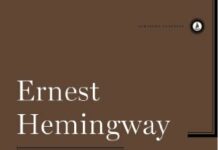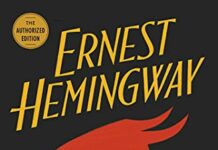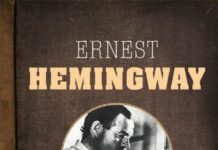
Ebook Info
- Published: 2009
- Number of pages: 160 pages
- Format: EPUB
- File Size: 4.67 MB
- Authors: Ernest Hemingway
Description
Ernest Hemingway’s classic memoir of Paris in the 1920s, now available in a restored edition, includes the original manuscript along with insightful recollections and unfinished sketches.Published posthumously in 1964, A Moveable Feast remains one of Ernest Hemingway’s most enduring works. Since Hemingway’s personal papers were released in 1979, scholars have examined the changes made to the text before publication. Now, this special restored edition presents the original manuscript as the author prepared it to be published. Featuring a personal foreword by Patrick Hemingway, Ernest’s sole surviving son, and an introduction by grandson of the author, Seán Hemingway, editor of this edition, the book also includes a number of unfinished, never-before-published Paris sketches revealing experiences that Hemingway had with his son, Jack, and his first wife Hadley. Also included are irreverent portraits of literary luminaries, such as F. Scott Fitzgerald and Ford Maddox Ford, and insightful recollections of Hemingway’s own early experiments with his craft. Widely celebrated and debated by critics and readers everywhere, the restored edition of A Moveable Feast brilliantly evokes the exuberant mood of Paris after World War I and the unbridled creativity and unquenchable enthusiasm that Hemingway himself epitomized.
User’s Reviews
Reviews from Amazon users which were colected at the time this book was published on the website:
⭐”If you are lucky enough to have lived in Paris as a young man, then wherever you go for the rest of your life, it stays with you, for Paris is a moveable feast.” Ernest HemingwayAmerican novelist Ernest Hemingway cloaked himself in a life that was every bit as exciting and colorful as those lived by the characters who populated his novels. Hemingway was born in Oak Park, Illinois. in 1899, the son of a country doctor who was an outdoorsman and a culturally refined mother who pushed her son toward the arts. Young Hemingway tried to join the US military as an infantry “foot soldier” in World War I, but was turned down because of poor eyesight. He ended up volunteering as an ambulance driver for the Red Cross on the Italian front, and after serving heroically and suffering multiple shrapnel wounds, he went on to enlist in the Italian infantry and saw service on the Austrian front.Hemingway and his first wife, Hadley Richardson, moved to Paris in 1921 – a century ago this year – where he wrote dispatches for a newspaper in Toronto and did freelance work for other newspapers and journals while honing his skills as a professional writer of stories and novels. Ernest spent his days holed up in the cafe’s of Paris where he did much of his writing, while Hadley explored the city and pursued her own interests. Together they traversed the Paris cultural scene and managed to see and experience much of Europe.Ernest Hemingway spent the better part of seven years in Paris (1921-1928) and kept the experiences that he and Hadley had while living there in a series of notebooks. He had always intended to eventually write about those early years in Paris. Sometime during the course of the 1920’s and 1930’s, the author lost track of his notebooks. Then one afternoon in 1956 while sitting in the lobby of the Ritz Hotel in Paris and enjoying a drink with the manager, a friend from the old days in Paris, the manager suddenly mentioned that he still had the two small steamer trunks that Hemingway had asked him t safeguard before World War II. Hemingway retrieved the wayward trunks, and as he was digging through the remains of his youth in Paris, he found his long-lost notebooks.The last writing project that Ernest Hemingway undertook was the editing and organizing of those notebooks into a book format. He had not completed the project when he died of his own hand in Idaho in 1961 as he avoided the final ravages of cancer. Hemingway’s third wife, Mary, completed the project. Not satisfied with her effort, Hemingway’s son, Patrick, and his grandson, Sean, reworked the project again after Mary’s death. This is a review of what is now referred to as the “Restored Edition” of Ernest Hemingway’s final work.Hemingway’s Paris is alive with the people who were the pillars of twentieth century literature and the arts. He talks of visits to Gertrude’s Stein’s apartment and her enthusiasm for his writing. Stein also encouraged him to spend his money – which was very limited – on “pictures” (art) rather than on clothing. At one point he confided to Hadley that Miss Stein could be quite a bore, and Hadley replied that she would not know because she was just a wife and she was relegated to only speaking with Miss Stein’s friend (Alice B. Toklas). Hemingway’s bent toward snobbishness is hinted at in his recollections of visits at the Stein apartment. He never refers to Toklas by name – only as Miss Stein’s friend – and although he talks of several encounters with Miss Stein’s maidservant – and mentions her personal kindnesses to him – he openly admits that he could not even remember her name.Hemingway in A Moveable Feast focuses on F. Scott Fitzgerald and his wife, Zelda, more than any of his other Paris literary contemporaries. He tells a wonderful tale about him and Scott, not long after they first met, going to Leon to retrieve Fitzgerald’s automobile – which had broken down – to drive it back to Paris. It turns out that the trip to Leon was the first time Scott had spent a night separated from Zelda since their marriage.The car they retrieved was a small Renault that had suffered damage to its top, and instead of having the damage repaired, Zelda had ordered that the top be removed. Right-on-cue as the two young authors began their road trip back to Paris, the skies opened up and it began raining. They spent several hours driving in and out of rain before deciding to get a room for the night. As soon as they settled into a room for the evening, Scott decided that he was sick – and he wanted his temperature taken.F. Scott Fitzgerald put his neurotic character on full display as he demanded that Hemingway or a member of the hotel staff produce a thermometer – of which there was not one to be had. Eventually after much complaining by the author of The Great Gatsby, a staff member showed up with a bath thermometer – with a wooden back and “enough metal to sink in a bath.” Hemingway joked that Fitzgerald was fortunate because it was not a rectal thermometer, and the clueless Scott then asked where it did go. His quick thinking friend told him that it was for an under-arm reading and proceeded to take his temperature and then announced that it was normal.But Scott did not trust the doctor’s son who had at one time been an ambulance driver for the Red Cross, and he demanded that Hemingway take his own temperature as well so that they could compare the readings. Hemingway complied and then announced that his numbers were the same and that he was fine – so F. Scott Fitzgerald decided that he must have recuperated.And then there was the issues surrounding Zelda Fitzgerald. Scott was totally besotted with Zelda, and Hemingway figured out quickly that Zelda was trying to sabotage her husband’s writing through alcohol and a lifestyle centering on partying. At a point not too long after their first meeting, Hemingway also experienced the sudden realization that Zelda actually was insane.Ernest Hemingway seemed to show disdain for many of the characters with whom he interacted in the Paris of the 1920’s. A pair of notable exceptions were poets Ezra Pound and Evan Shipman. Every mention of Pound was almost reverential, and he described in glowing terms Pound’s efforts at setting up a charitable foundation to free poet T.S. Eliot from the soul-depleting drudgery of having to work in a London bank to support himself. Young Evan Shipman was an unpublished poet who earned Hemingway’s respect and lifelong friendship by doing things of a practical nature like actually digging in the soil to produce gardens to feed others.Ernest and Hadley’s only son, Jack (later the father of Margaux, Mariel, and Joan), was born during the Paris years while they were home in Canada in 1923. He returned to Paris with his parents as a tiny infant who had to be barricaded into his ship’s bunk during a hard trans-Atlantic winter crossing. The new parents nicknamed their son “Bumby” and raised him in an unconventional manner. According to the father’s recollection, Bumby, who was a good baby who seldom fussed or cried, was sometimes left in the care of F. Puss, the family cat, while father wrote in the local cafes and mother ran errands. Bumby and the cat would curl up together and sleep on the apartment floor. Later, as Bubmy began becoming more mobile, he would accompany his father to the cafes where he knew to sit silently and observe others while his father wrote.Hemingway and Hadley split up in their sixth year of marriage as he began having an affair with a friend of Hadley’s who was living with them. He describes that slow and very painful transition from one lover to another in a chapter in The Moveable Feast entitled “The Pilot Fish and the Rich.” It is the best writing in the book.Hemingway’s breakup with Hadley clearly impacted him deeply and reached across the decades. In several “fragments” of his writing that he had penned especially for this effort and that his heirs chose to include at the end of the book, he referred to Hadley as the “heroine” of the stories. Clearly he never got over her.And there is so much more to this fine memoir. Time spent reading it is time that will be savored.The feast moves onward and continues to nourish.
⭐This was one of Hemingway’s last works in process when he committed suicide, appearing in print three years later. It provides a series of annotated snapshots of his days in Paris and about Europe while he was a hungry (often literally) expatriate author, sure of his gifts, and impatient for the world to reach a similar appreciation.Brief, only novella length, it provides, in addition to the author’s own account of his and his first wife’s early years, descriptions of several seminal literary figures in the inter-war period, principally Ezra Pound (laudatory), Gertrude Stein and F. Scott Fitzgerald (relatively sympathetic) and Ford Maddox Ford (cruelly derogatory, despite the great assistance Ford gave to Hemingway’s career).As such, it provides tantalizingly provocative insights into how the larger than life, lionized, ever image-conscious author wished his literary origins to be understood. And, just occasionally, wonderful flashes of his early, by then largely extinguished gifts. Here is one example:“I remember all the kinds of snow that the wind could make and their different treacheries when you were on skis. Then there were the blizzards when you were in the high Alpine hut and the strange world that they would make where we had to make our route as carefully as though we had never seen the country. We had not, either, as it all was new. Finally towards spring there was the great glacier run, smooth and straight, forever straight if our legs could hold it, our ankles locked, we running so low, leaning into the speed, dropping forever and forever in the silent hiss of the crisp powder. It was better than any flying or anything else, and we built the ability to do it and to have it with the long climbs carrying the heavy rucksacks. We could not buy the trip up nor take a ticket to the top. It was the end we worked for all winter, and all the winter built to make it possible. During our last year in the mountains new people came deep into our lives and nothing was ever the same again. The winter of the avalanches was like a happy and innocent winter in childhood compared to the next winter, a nightmare winter disguised as the greatest fun of all, and the murderous summer that was to follow. It was that year that the rich showed up.”
⭐I read this book after reading In Our Time and it’s fascinating, unbelievable really, to see how Hemingway struggled to see his stories in the early days. This is the author’s memoir of his days as a young writer in Paris. He describes the struggle he had to sell his stories, and when you read In Our Time you wonder what publishers and readers were looking for in those days. It seems to me that the stories in In Our Time would do credit to a much more mature writer than Hemingway was when he wrote them. Yet, at the time he was writing them he and his wife were struggling to pay the bills, counting every penny, skipping meals. And meals are very important to Hemingway. Along with alcohol. As with much of his fiction, when Hemingway has the money, he really digs in and there are plenty of alcohol-fuelled encounters with poets, painters and novelists here. Perhaps the most memorable is a hilarious encounter with F Scott Fitzgerald. They arrange to go to Lyons together to collect Fitzgerald’s car which he and his wife had abandoned there. Despite Hemingway’s careful arrangements, they end up going down to Lyons on different trains and staying in different hotels. Eventually they meet up and collect the car, which turns out to have no roof; and this was the reason they abandoned it as they had no waterproofs either. After a couple of stiff drinks they set off for Paris with Fitzgerald at the wheel, and of course it rains several times and they get completely soaked. They take refuge in a hotel where Fitzgerald turns out to be a flaky hypochondriac. He takes to his bed demanding that Hemingway goes out and finds a thermometer and aspirin, believing he’s now terminally ill with pneumonia and needs to get to an American hospital asap as he can’t trust French doctors. Hemingway, of course, prescribes whisky, which works. I’ll say no more. This is a brilliant memoir, written in Hemingway’s characteristically terse, lean style. It’s poignant when you think about the whole of Hemingway’s career and realise that those early poverty-stricken years when he was struggling to make his name as a writer were probably his happiest and best years, personally and professionally.
⭐There can be no doubt that Ernest Hemingway was a very very very fine writer. But I don’t think he was a very very very nice man. This is an account of his early years as a writer in Paris, with Hadley his wife and, a bit later, little Bumbly their blond haired rosy cheeked son. This was Paris in the 20s – we now know it was between the Wars – and there were ex-pat writers filling up every cafe terrace. This is Hemingway struggling to get going, single-minded, driven, increasingly obsessed by his Art and by himself as a writer. This is him determined for success, pushing his way forward, clambering over everything, grabbing at anything. No, not a very nice man. But the writing’s superb, even if his accounts of fellow writers – Gertrude Stein, Scott Fitzgerald, Ford Madox Ford, Ezra Pound – do err on the side of the ungenerous, even if you wonder where his devoted anchor of a wife is most of the time, even if little Bumby gets hardly a mention; there’s no denying the writing’s fine. This is Hemingway going for it, really going for it, before success comes and, well, that’s a whole different story.
⭐This is a piece of ‘late Hemingway’ looking back at his young life in Paris during the 1920s. As always with Hemingway, the food and drink (particularly the drink) are brilliantly described – he was a great travel writer. Hemingway evokes a particular vision of Paris – that of the ex-pat rather than the insider. In spite of some of the supposed ‘revelations’ about, for example, Scott Fitzgerald (which might have been best left unsaid) the book is nevertheless worth reading. Perhaps read alongside Richard Cobb’s essays ‘Paris and Elsewhere’ for a rather different ‘take’.
⭐I had the good fortune to live in Paris as a young man and as well as being a fascinating insight to Hemingway’s own psyche, friendships with Scott Fitzgerald and Gertrude Stein it also paints a clear portrait of a city in a unique era – all through his brilliant and direct and old school prose. It made me hungry and thirsty and want to go back to Paris to walk in the gardens and take in the paintings .
⭐I came across this as a result of a mention in a news item following the Paris shootings. So I probably would not have read it, or in fact known about it, but for that item.I thoroughly enjoyed this book for a number of reasons, but mainly, I like Hemingway’s style of writing, his humour, and observations. I think this book has a certain timeless feel to it, and sums up perfectly the spirit of 1920’s and maybe 21st Century Paris (hope so).Anyway that said, I am now a Hemingway convert, and I plan to read some more of his works.
Keywords
Free Download A Moveable Feast: The Restored Edition in EPUB format
A Moveable Feast: The Restored Edition EPUB Free Download
Download A Moveable Feast: The Restored Edition 2009 EPUB Free
A Moveable Feast: The Restored Edition 2009 EPUB Free Download
Download A Moveable Feast: The Restored Edition EPUB
Free Download Ebook A Moveable Feast: The Restored Edition





